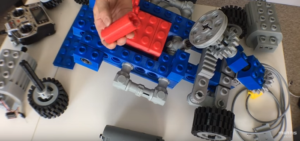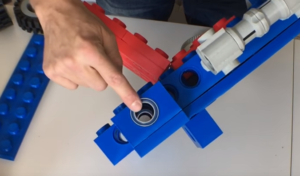 It’s time for another update from one of our favorite makers – Matt Denton, one of the original builders of Star Wars droid BB-8, owner of YouTube channel Mantis Hacks, and maker of 3D printed LEGO vehicles extraordinaire. As a kid, Denton enjoyed building vehicles and other machines with LEGO Technic kits, and decided to share that love with his eight-year-old nephew Ruben by scaling up a 98-piece LEGO Technic Go-Kart set with 3D printed parts five times the size of the originals for him to ride on.
It’s time for another update from one of our favorite makers – Matt Denton, one of the original builders of Star Wars droid BB-8, owner of YouTube channel Mantis Hacks, and maker of 3D printed LEGO vehicles extraordinaire. As a kid, Denton enjoyed building vehicles and other machines with LEGO Technic kits, and decided to share that love with his eight-year-old nephew Ruben by scaling up a 98-piece LEGO Technic Go-Kart set with 3D printed parts five times the size of the originals for him to ride on.
 While the LEGO go-kart ended up not being quite big enough for his nephew to fit on, they still had fun racing each other to build the kits – Denton built the 3D printed version, while Ruben worked on the original 1985 kit. In fact, they had so much fun, the two decided to work on another 3D printing project together, this time with a LEGO Technic Kit for a much larger forklift. It took Denton over 500 hours to scale up all 216 pieces of the forklift kit and print them out on his LulzBot 3D printers, before he and Ruben were able to sit down and assemble it together.
While the LEGO go-kart ended up not being quite big enough for his nephew to fit on, they still had fun racing each other to build the kits – Denton built the 3D printed version, while Ruben worked on the original 1985 kit. In fact, they had so much fun, the two decided to work on another 3D printing project together, this time with a LEGO Technic Kit for a much larger forklift. It took Denton over 500 hours to scale up all 216 pieces of the forklift kit and print them out on his LulzBot 3D printers, before he and Ruben were able to sit down and assemble it together.
Denton told 3DPrint.com last month, “Well no sooner had I built the Giant LEGO Go-Kart than I was thinking I’m going to have to motorize it!”
 After 3D printing several giant LEGO motors that contained working motors and attaching them to the 3D printed go-kart, Denton took it out for several test runs to see how well it would work with a remote control. While he did have to reattach a few parts with glue and zip ties in the process, the go-kart ended up reaching a top speed of 26 km per hour, maintaining an average of 12.6 km per hour.
After 3D printing several giant LEGO motors that contained working motors and attaching them to the 3D printed go-kart, Denton took it out for several test runs to see how well it would work with a remote control. While he did have to reattach a few parts with glue and zip ties in the process, the go-kart ended up reaching a top speed of 26 km per hour, maintaining an average of 12.6 km per hour.
Denton promised viewers in his video last month that he would soon be releasing another video that detailed just how he built the “giant-scale LEGO motors” and the modifications he had to make in order to get it up and running. Finally, he has delivered, just in time for Christmas!
Episode 14 of Mantis Hacks, “Motorizing the Giant LEGO 3D Printed Go-Kart,” was released earlier this week.
“In this video I’m going to be taking a look at the modifications I made to the giant LEGO 3D printed go-kart, and the modifications made it radio-controlled,” Denton says in the video introduction.
He begins with an overview of the system itself, and then actually disassembles the go-kart, in order to give viewers a look at its RC functions “piece by piece.”
A round, gray battery box on the right side of the go-kart sends power through a yellow connector into a separate connector, which is located on the drive motor on the back of the go-kart; a pulley connects this motor to the back wheels, so they can actually spin and get the car moving. Power and signal cables from the back connector are connected through additional pulleys to the front servo motor.
“Also you’ve got the antenna here, which isn’t really being used at the moment, but the idea was that the antenna…there’s two signals, drive and turn signal, and they were supposed to come from this receiver inside of the antenna, buried in there,” Denton explained. “But the receiver broke…so I had to put this one on temporarily, which is a bit of a mess, but it would have looked much better had that have worked.”
Denton explained that he had to add a few modified, 3D printed blue LEGO blocks, with bearings inside, at the front, to help the servo motor sit properly; he also had to “step the wheels out a bit” on both sides of the go-kart, in order to add a T5 pulley, 3D printed a red piece in order to join the drive shafts together at the back, and re-printed the front steering arms and added bearings inside.
- Drive shaft piece
- Wheel bearing
To take a closer look at all of the modifications, and at the RC motors themselves, take a look at Denton’s latest YouTube video:
Discuss this and other 3D printing topics at 3DPrintBoard.com or share your thoughts below.
[Images: Matt Denton via YouTube]
Subscribe to Our Email Newsletter
Stay up-to-date on all the latest news from the 3D printing industry and receive information and offers from third party vendors.
Print Services
Upload your 3D Models and get them printed quickly and efficiently.
You May Also Like
Reinventing Reindustrialization: Why NAVWAR Project Manager Spencer Koroly Invented a Made-in-America 3D Printer
It has become virtually impossible to regularly follow additive manufacturing (AM) industry news and not stumble across the term “defense industrial base” (DIB), a concept encompassing all the many diverse...
Inside The Barnes Global Advisors’ Vision for a Stronger AM Ecosystem
As additive manufacturing (AM) continues to revolutionize the industrial landscape, Pittsburgh-based consultancy The Barnes Global Advisors (TBGA) is helping shape what that future looks like. As the largest independent AM...
Ruggedized: How USMC Innovation Officer Matt Pine Navigates 3D Printing in the Military
Disclaimer: Matt Pine’s views are not the views of the Department of Defense nor the U.S. Marine Corps Throughout this decade thus far, the military’s adoption of additive manufacturing (AM)...
U.S. Congress Calls Out 3D Printing in Proposal for Commercial Reserve Manufacturing Network
Last week, the U.S. House of Representatives’ Appropriations Committee moved the FY 2026 defense bill forward to the House floor. Included in the legislation is a $131 million proposal for...





































